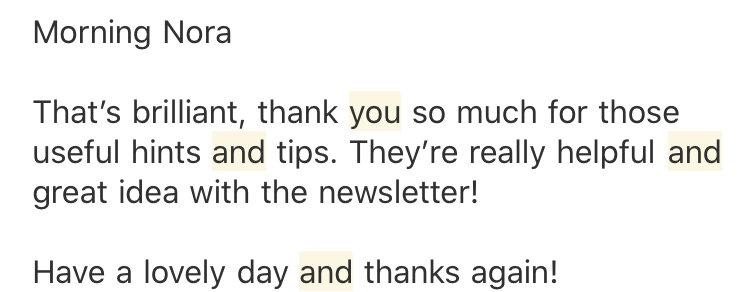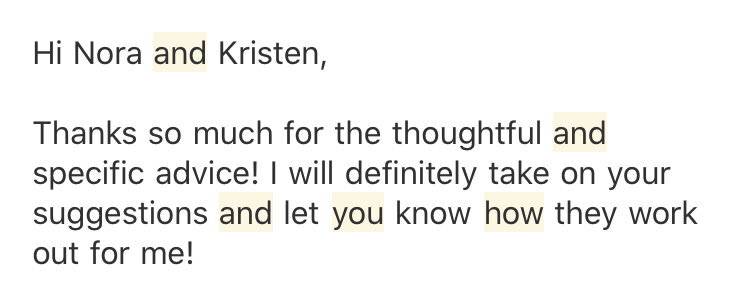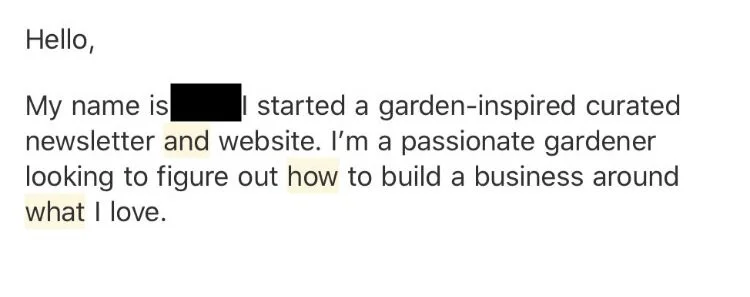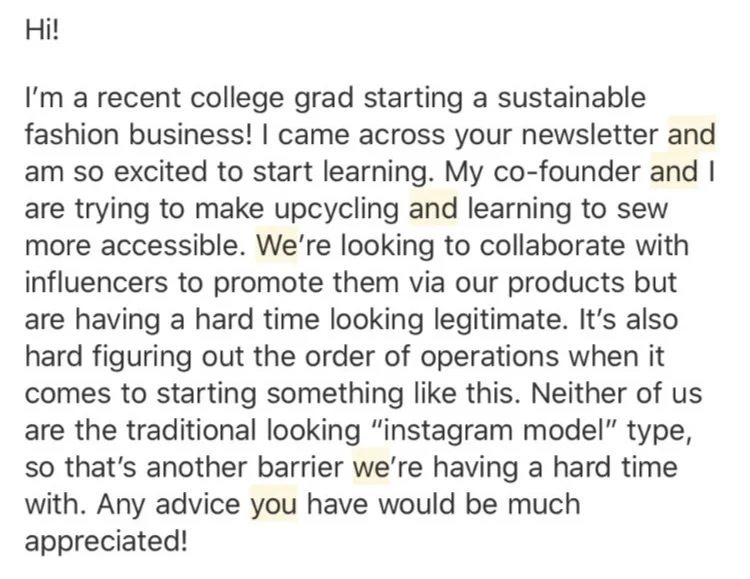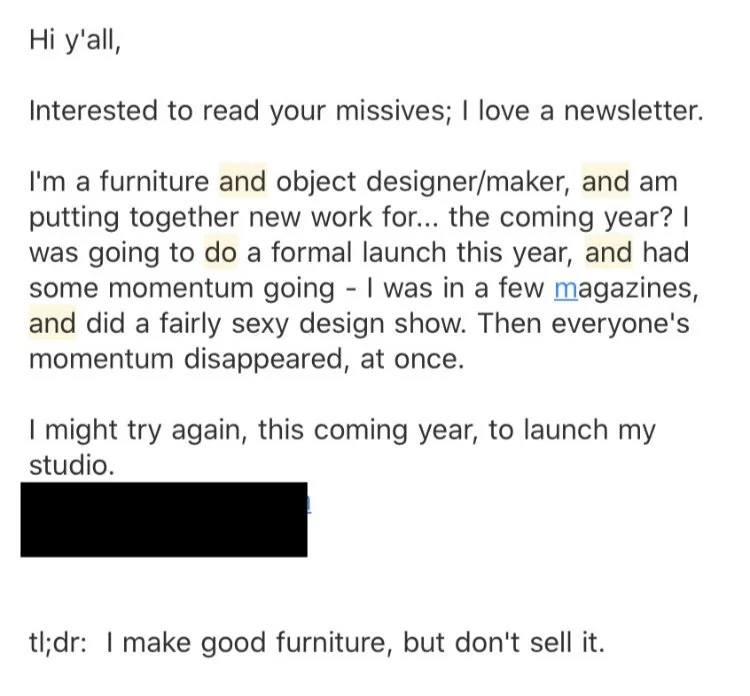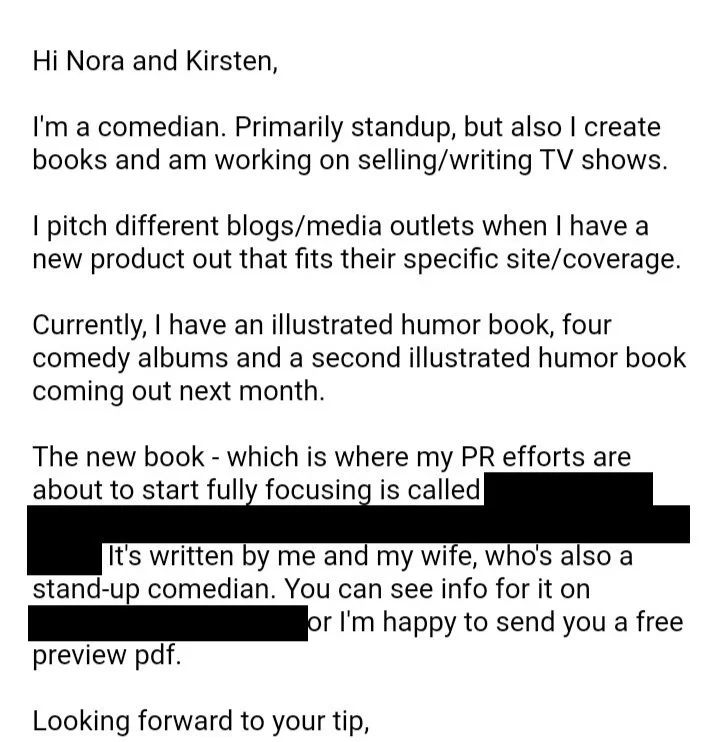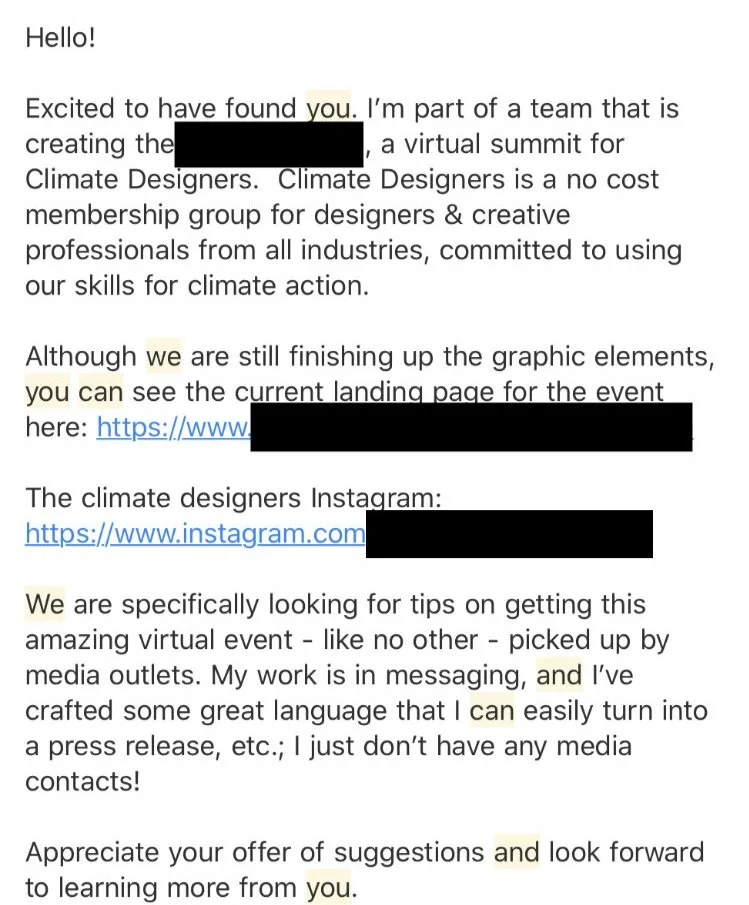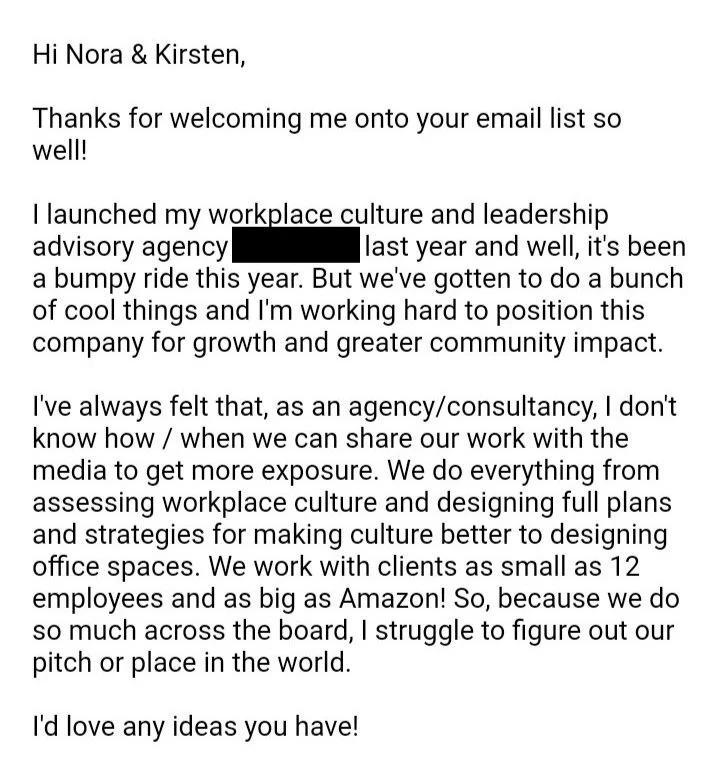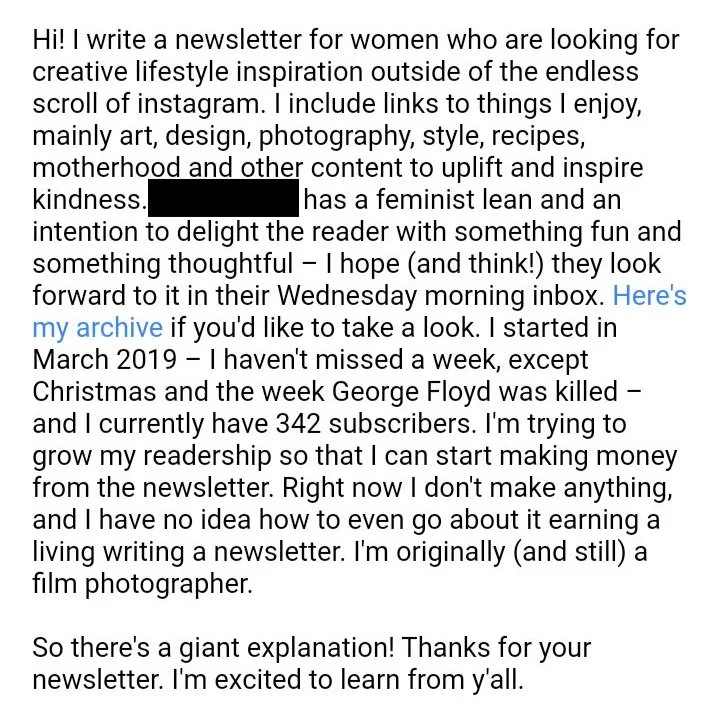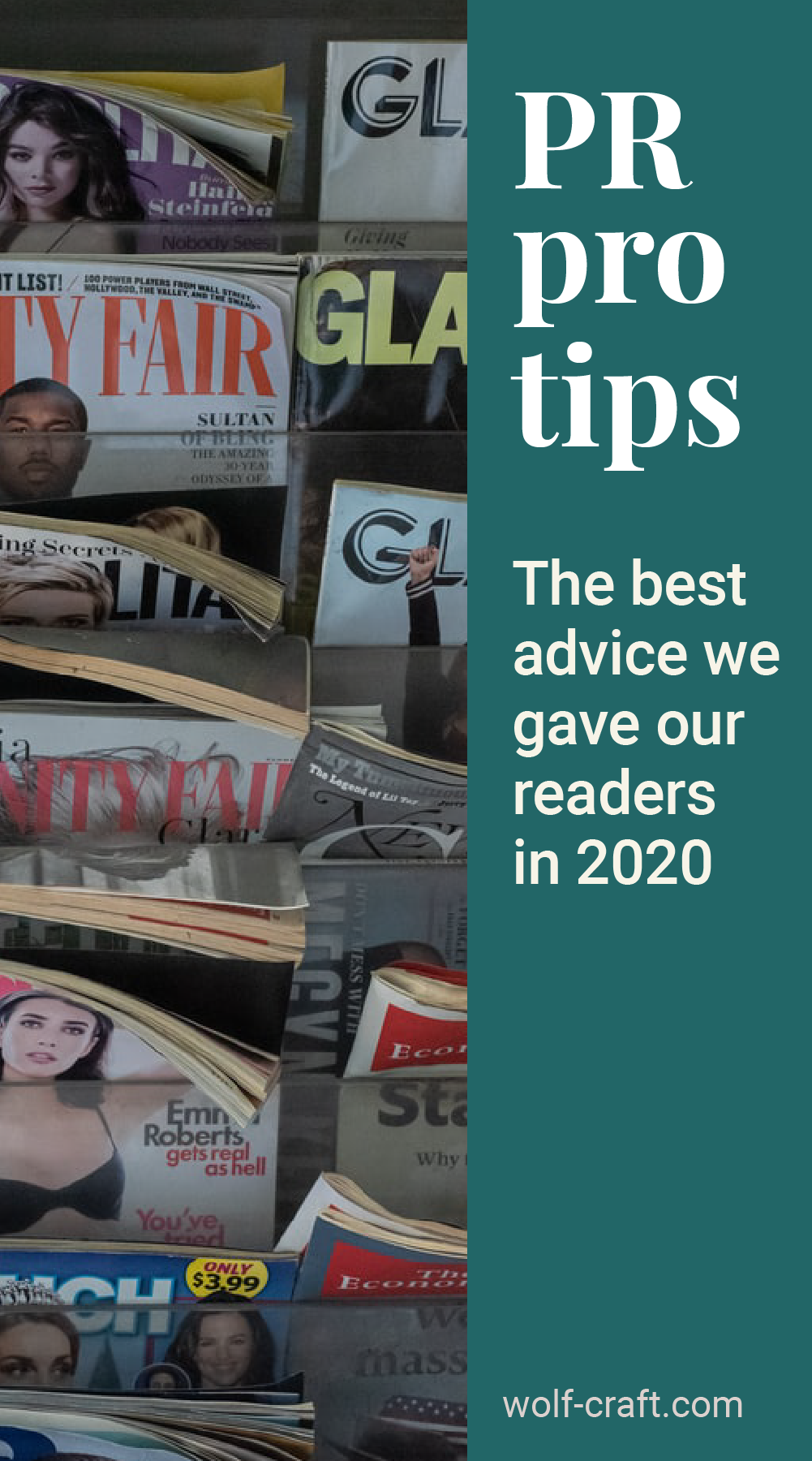The Best PR Tips We’ve Given to Our Newsletter Subscribers
If you subscribe to our newsletter you may have noticed that our welcome is *really* welcoming. Often, new subscribers send over their websites and tell us about their work. More times than not, we reply with a specific suggestion. So, we compiled some of the best PR tips we doled into this post.
Below you’ll see our favorite PR tips that solicited replies such as:
1. Tell the stories you want to see in the media
As you grow your business you will want to try and get press about you and/or your company as a whole, so you need to tell those stories on your site, through your blog, through your introduction copy, and through your social media.
It’s important to clearly state what you do and what your values are. BUT if you want PR you need to create more in depth stories about your brand, projects, and collections. Editors, potential buyers, and stans need to understand what sets you and your company apart from your peers.
PR tips about showcasing process
“We suggest you make a blog post for each of the pieces you really like so you can tell the story of your work - from design concept, sketches, prototypes and models, to production.
You should do this for each of your new pieces/collections.”
PR tips about going beyond brand values
“Right now your web graphics layout what you do and your values but don’t really go beyond that. We suggest you create blog posts to tell several in-depth and authentic stories with images about the whole process of sourcing, finding farmers, drying the teas, working with local retailers. Show your fans and editors your whole process.”
For more PR tips about process check out, Why documenting everything is important for PR.
The case study in this post is about furniture design, but the concepts -- breaking down and documenting a whole process -- are useful to anyone writing about how their projects and work come to fruition.
If you don’t already be sure to check out Design Milk’s recurring feature Deconstruction.
2. Be a thought leader
The media loves a thought leader, and no you don’t have to be the CEO of a fortune 500 company to be one. If you run a business, you are likely already an expert.
Are you a furniture designer who’s an expert in the circular economy and buy-back programs?
Are you a travel photographer who can help people take great images with their phones?
Are you a boutique food brand that knows all about sourcing local ingredients?
PR tips about how to be an expert
“While it’s relatively rare for media outlets to write about digital courses, they do write about thought leaders- and you CLEARLY are one. Instead of looking to promote your course via press, look to promote your tips. Find publications that write stories like “TK Expert Share 5 TK Tips!” Then offer to share your tips, or to do a guest post. Another outlet worth looking into is podcasts. Look for ones that speak directly to your target audience, like small business podcasts for female entrepreneurs. Since the Gmail organization work you do is largely visual you may want to make a 1-page freebie for podcast listeners that can be linked in the podcast notes.”
PR tips about how to pursue thought leadership press opportunities
“Research editors and publications that write about your topic, home gardening. There are a lot of outlets that write a huge range of DIY-home-related articles. Reach out to them to introduce yourself and your expertise. Hopefully some or several will keep your contact information and come to you when they need an expert quote in this area or are working on a garden-related feature.”
Another key PR tip here. Ask for what you want.
We encourage you to be very clear and up front on your website about the opportunities you are looking for, especially in your bio/about section.
Something like “I speak on podcasts, write for publications, do in person/video workshops...etc.”
3. Take *great* media quality photos.
If you read our newsletter you’ll come to learn that we're a bit of a broken record when it comes to photography.
Great photography is truly the most important part of press outreach.
Magazines and blogs are essentially big picture books. There isn’t a design editor in the world who will care about what you’re working on if you don’t have big, beautiful photos to go along with it. Design is visual first, and everything else second.
PR tips about what to prioritize
“Photography is one of your most important assets, and you don’t have a lot. If you were to do only one thing we suggest building out your assets. You’re using stock photography and it shows. Take high quality photos of your DIY kit, of you sewing something, and of people wearing the final products.”
PR tips about what to pay attention to during a photoshoot
“For many of your pieces it looks like you tried to create silhouette (all white background) shots, but they didn’t quite work out. For silhouette shots the shadows should be minimal or non existent and the background should be completely even and white (no wrinkles, creases, extra shadows, etc.). For some of the images this is maybe fixable in Photoshop, but it’s hard to tell, for others you will have to reshoot to have media quality images. Another point, you’ll want to be sure to lens correct / perspective correct your images- for example, when shot straight on on the bedside table’s edges should be completely parallel to the edges of the image.”
Be sure to check out our Pinterest account, which includes tons of individual boards dedicated to media-quality photography ranging from residential interiors, to lighting, to tech products, textiles, accessories, consumables, and more.
If you’re feeling ambitious we created 3 guides dedicated to photography for media outreach.
4. Organize your assets.
Put yourself in an editor’s shoes. They have no budget, no time, and are bombarded with emails requesting coverage. If you want to rise to the top, you have to make their lives easier.
We advise everyone who is pitching editors to create personalized Dropbox or Google Drive folders for each editor so they have easy access and are not sifting through folders or dealing with unorganized zip files. When you do this you should also develop a file naming system that will be as easy as possible for editors to understand, like: “company_productname_number.jpg” or “productname_company_number.jpg”
PR tips about preparing your assets for media outreach
“The “download high res photos” link on your website is a little unclear. Editors and people in general don’t tend to click on download links where it’s not super clear what will be downloaded. We suggest you create a bulleted list (perhaps with low res versions of the images) with individual files that can be downloaded.
For future media outreach you can also create a dropbox/shared folder where all your assets live (including bio photos) to share with editors. They much prefer cloud-based file sharing over emailed zip folders and files.”
PR tips about checking pitch emails
A quick heads up, the images embedded in the email you sent to us didn’t come through (it was just the jpg icon). We’ve also found that Gmail can be a bit of a pain with embedded images. When you start pitching to editors, it’s always good to send a test email to a colleague or second account to make sure the images work. Email embedded images should always be a low-res version so as to not slow down loading time.
5. Make sure what you do is crystal clear
Put yourself in the shoes of someone (like an editor who gets 100 emails a day) who has never heard of you and an email about you popped in their inbox. The first thing they are going to do is go to your website and your Instagram.
You have a few seconds before they decide to stay on your site or move on to something else. What you do and who you are needs to be crystal clear right up front.
PR tips about clarifying what you do
As your site currently is, the Home/Away concept and what you’re doing is a little hard to understand straight off the bat. It was actually much clearer in the email you sent here. We think it would be beneficial to create one very clear short paragraph to describe what you do that can live on your landing page, and potentially at the top of the individual Home and Away pages (since people are in the habit of clicking off landing pages and not reading anything). Expand on this on your about page, more specifically what you actually DO. Your about copy is poetic right now but hard to tell what the site is, what you do, and importantly what you want to be doing in the future and who you want to be working with (where you’re going).
PR tips to write your ‘about' copy
“One quick note about language and how you are describing the event. On the homepage potential attendees and editors will want to know right up front what exactly they'll get out of the event. Your first bit of ‘about’ copy feels a little unclear. What are the tools, concrete learnings or, collaboration opportunities that the event provides?”
If you are finding this post helpful we think you’ll get a lot out of our
5-Day Pitch the Media Mini Course
6. Know what your peers are doing well
We’ve all had that moment where we see press on a peer company and think “I can imagine my product/ project/brand in this article.” If this has crossed your mind you know exactly where to start your research.
Look at the companies who you admire and aspire to, the ones that have a greater reach. Follow them on Instagram, read their newsletters, go to their press pages and understand what photos and activities are getting them press. Make metrics based on this research, like, media outlets, story angles, and types of photos and styling.
Doing PR on your own can be overwhelming and it can be hard to know where to start, we’ll always say that the best place to start is research!
PR tips about using peer research to guide media strategy
“We think you would really benefit from the first homework assignment Nora always gives 1-1 consulting clients. Find 5 peer companies (those that are slightly aspirational/ 2-5 years ahead of you in their career *and* have press coverage) and look at the press coverage they are getting. You can make metrics based on this research and start to create a roadmap for asset creation, pitching/pitch angles, publications you may want to reach out to, etc.
Also, wee suggest you address workplace culture in this COVID time in a prominent way on your homepage and across the site so it plugs into topical news stories.”
PR tips about peer research
“Look at peers you admire who are doing a better job of ‘getting the word out’. How are they creating stories around difficult issues? What does related press looks like? Look at the types of partnerships they have, general website layout elements that are effective, social media + CTA, etc. This work takes time but it’s invaluable in building out an effective messaging and content strategy.”
7. Have a newsletter & supercharge your sign-up
Every business must have an email list and an inviting sign-up form on their website. This isn’t only true for bloggers and consultants but also for independent brands and designers. Email is the number one way to communicate with anyone- future clients, collaborators, and fans. You should be using your list to share the stories you’re telling in your blog, plug press features, and announce your new projects.
PR tips about newsletter formatting
“We’ve looked at several past issues and it looks like you have a lot of great resources and links but they get a bit lost in the formatting (aka, all the text is the same size, there aren’t any headings, line breaks or images). This has been studied a lot and humans have preferences for how they digest text, make sure you’re designing your content so it appeals to those preferences. We think creating hierarchy and wayfinding are going to be really important to better structure your content. We’re all for text-based design, or minimal designed newsletters, but make sure you’re designing so your readers can easily digest your work. One great example of this is swiss miss’s newsletter. I would also check out For The Interested and A Thing Or Two.
One good exercise could be taking two of your past editions and rewrite a few different versions. Include images, headings, wayfinding elements, etc. Show these reworked newsletters to some friends to get feedback on what they liked more.”
PR tips about newsletter sign up copy
“Adjust the language slightly on your newsletter sign-up on your homepage, “Newsletter Name” helps experienced home gardeners build their dream gardens”. It seems like your audience is both experienced and beginner gardeners. Make sure the beginners feel like the newsletter is for them too.”
8. Get ready for influencer partnerships
How to get started with influencer partnerships is a question we’ve been getting a lot. So much that we’ll be doing a more extended post on this topic in the coming months. In the meantime, if you are just getting started we suggest you start small when it comes to initiating influencer partnerships.
Someone with 5,000 or 10,000 very engaged followers in that overlap with your ideal client may be the perfect fit in this moment. And they’ll be easier to be in touch with. Also, don’t forget to ask your friends and network to share your content once it starts moving.
PR tips about collaborations & influencer
partnerships
“Because your work is so unique and colorful it will really stand out on social media and we think influencer partnerships could really work well for you. These don’t have to be people with huge followings, look for your ideal client or the people your ideal client follows, someone who is also maybe in the sustainability, youth, or lifestyle space. If some of the artists you collaborate with have larger followings be sure to photograph them in your garments so they can share across their accounts.”
PR tips about getting ready for influencer partnerships
“Right now it looks like your site has most of the “bones” it needs to build out a bit more before you start looking for influencer partnerships. We suggest making a 6-month content plan before you start looking for partnerships. This could entail something like 2 blog posts a month, 3-4 Instagram posts a week, 3-4 Instagram stories a week of you talking about the project, sewing, etc., a monthly email to people on your list where you share what you’re doing in a more personal way (include links to your blog posts here), and more product available to purchase on your website. You want to feel confident when you reach out to potential collaborators and you truly need more content and product available to purchase when you do this.”
9. Pitch your products to gift guides.
One of the biggest opportunities for press happens around the holidays. Publications that typically don’t feature products, like a fitness magazine, open their pages for product coverage. You can find holiday gift guides in niche titles you normally wouldn’t be able to work with, vastly increasing the amount of PR opportunities! Check for yourself- our Gift Guides Pinterest board includes links to dozens of past guides.
If you think your products may be a good fit for gift guides be sure to watch our *free* workshop all about how to increase brand awareness with holiday gift guide press.
PR tips about pitching gift guides for F&B brands
“We think you could have a lot of success pitching to holiday gift guides next year, especially considering you already sell a gift set! You’ll want to look for guides like “the foodie in your life”, guides that focus on sustainable products and/or consumables, and guides in local publications that like to support local brands. We’ve done a TON of pitching holiday gift guides for clients over the past 10 years and this year we’ve seen quite an exciting uptick in publications featuring sustainable/locally made/ artisan/BIPOC-owned brands.”
PR tips about what products to select for holiday gift guide pitching
“We think you could have a lot of success pitching to holiday gift guides if you’re willing to make a batch of work ahead of time.
Pick 2 or 3 things that are your best sellers (accessories may be a better option than garments because you don’t have to worry about sizing) and focus on just pitching those.”
If your products are a good fit for gift guides and you want the full “how to” road map down to a weekly outreach calendar and specific email scripts for editor outreach check out our How to Pitch for Holiday Gift Guides course.

